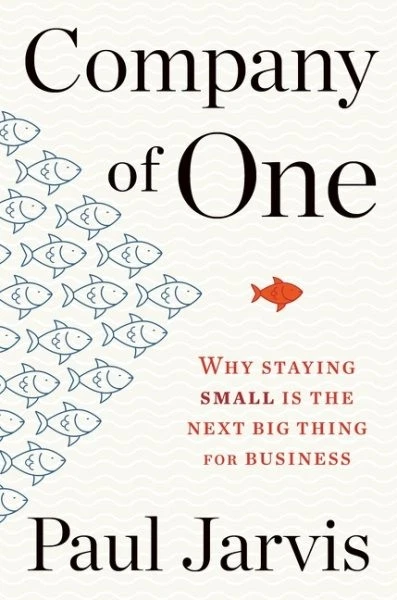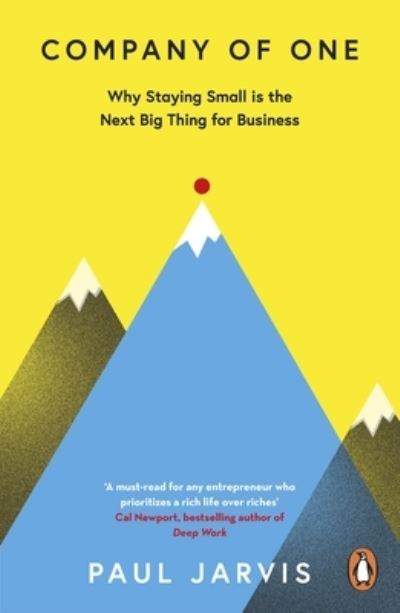In the modern world where “growth at all costs” seems to dominate the business landscape, Paul Jarvis offers a refreshing perspective with his book Company of One: Why Staying Small Is the Next Big Thing for Business.
In this detailed summary book of Company of One, we’ll explore the key lessons, ideas, and insights that Paul Jarvis shares lessons that are transforming how entrepreneurs, freelancers, and business owners think about success.
What is Company of One About?
Company of One is not just a book about running a small business; it’s a philosophy. Paul Jarvis challenges the traditional mindset that a successful business must constantly grow in size, revenue, and staff.
Instead, he advocates for building businesses that are intentionally small, highly profitable, personally fulfilling, and sustainable over the long term.
In essence, being a “Company of One” means prioritizing autonomy, purpose, and sustainable profits over endless expansion. It’s about designing your work to support your life, not the other way around.
This summary book of Company of One will now break down the book’s major ideas and how you can apply them.
1. Growth Isn’t Always Good
One of the core ideas in Company of One is that growth is not inherently good. Many businesses pursue growth without questioning if it will make their operations more difficult, costly, or less enjoyable.
Paul Jarvis asks: “What if you built a business that was better, not bigger?”
Instead of chasing new clients, bigger offices, or dozens of employees, a Company of One focuses on:
- Serving fewer clients better.
- Increasing profitability instead of size.
- Reducing complexity to improve quality of life.
This flips the traditional startup narrative. Growth is only pursued if it genuinely serves your goals, not because it’s expected.
Key takeaway:
Question every opportunity for growth. Only pursue expansion if it aligns with your values, lifestyle, and sustainability.
Related Post: The Ultimate 2025 Guide: Best Business Books Every Small Business Owner Should Read
2. Autonomy Over Empire
Another central theme in this summary book of Company of One is the importance of autonomy.
Many entrepreneurs start businesses seeking freedom but end up trapped, overwhelmed by managing employees, large client bases, and financial pressures.
In contrast, a Company of One prioritizes:
- Having control over your time.
- Making decisions without layers of management.
- Working directly with clients or customers.
- Structuring the business to serve your ideal life, not dominate it.
Jarvis shows that real success is not about the size of your company, but about the freedom to work how, where, and when you want.
Key takeaway:
Design your business around your desired lifestyle, not around traditional expectations of success.

3. Start Small, Stay Smart
In a traditional business model, the goal is often to scale rapidly.
But in Company of One, Paul Jarvis emphasizes starting small and staying small intentionally.
Rather than aiming for a quick exit (like selling a startup), the goal is to build something sustainable and lasting.
Small businesses can:
- Adapt quicker to changes.
- Offer personalized services.
- Build deeper customer loyalty.
Being small gives you the agility and flexibility that larger companies lose.
Key takeaway:
Smallness is a strength, not a weakness. Embrace it.
4. Focus on Resilience, Not Scaling
In this summary book of Company of One, resilience is a critical concept.
Paul Jarvis highlights that the real danger for businesses is not staying small — it’s fragility caused by rapid, unsustainable growth.
Many businesses collapse under the weight of their own expansion because:
- Overhead costs skyrocket.
- Customer service deteriorates.
- Decision-making becomes slower and more political.
Instead of chasing scaling metrics, Jarvis suggests focusing on building resilient systems:
- Strong customer relationships.
- Profitable, lean operations.
- An efficient and manageable workload.
Key takeaway:
A resilient, profitable business is better than a bloated, risky one.
Related Post: The Ultimate 2025 Guide: Best Business Books Every Small Business Owner Should Read
5. Serve the Right Customers
Another key principle in the summary book of Company of One is about choosing who you serve carefully.
Rather than marketing to “everyone,” Jarvis encourages businesses to:
- Identify the right customers.
- Deliver extraordinary value to them.
- Build loyalty and word-of-mouth referrals.
Trying to please everyone leads to mediocrity. Specialization and focus allow small companies to compete against bigger players effectively.
Key takeaway:
Better to deeply serve a small audience than poorly serve a large one.

6. Build Systems, Not Chaos
If you’re staying intentionally small, it’s vital to build systems that make your business sustainable.
Paul Jarvis shares that automation, documentation, and streamlining processes are crucial.
Systems allow a Company of One to:
- Save time.
- Reduce errors.
- Deliver consistent results.
- Create freedom for the founder.
For example, creating templates for client proposals or automating email responses can drastically reduce busy work.
Key takeaway:
Well-designed systems create more freedom and fewer headaches.
Related Post: The Ultimate 2025 Guide: Best Business Books Every Small Business Owner Should Read
7. Define Your Success
Traditional success metrics — revenue, employee headcount, office size — don’t apply in Company of One thinking.
Instead, Paul Jarvis urges readers to define success personally:
- Is it working four hours a day?
- Is it taking six months off per year?
- Is it earning enough to support a simple, happy life?
By detaching from external expectations, you gain clarity on what truly matters.
Key takeaway:
Success should be personal, not societal.
8. Always Question Growth
Throughout Company of One, Jarvis keeps returning to one vital question:
“Will this opportunity actually improve my business or life?”
He argues that every decision should be evaluated through this lens, whether it’s taking on a new client, hiring staff, or launching a new product.
Many businesses crash because they say “yes” to everything.
Smart entrepreneurs are selective — they understand that more is not always better.
Key takeaway:
Selective growth is smart growth.
Final Thoughts on Company of One by Paul Jarvis
In a world obsessed with scaling, Company of One offers an inspiring, practical, and deeply freeing alternative.
It’s a call to focus on meaningful work, profitable simplicity, and personal freedom.
If you’re an entrepreneur, freelancer, or creative professional who values independence over empire, the lessons from this summary book of Company of One can transform how you build and run your business.
Remember: staying small can be your biggest competitive advantage.
Why Read the Summary Book of Company of One?
This summary book of Company of One provides an essential roadmap for anyone tired of the “hustle harder” culture.
Whether you’re a solopreneur, coach, consultant, freelancer, or small business owner, Company of One shows a smarter, saner way to build a fulfilling, profitable business — without losing your freedom or peace of mind.
If you’re considering reading Company of One, or you want the key ideas without going through the full book, this summary gives you everything you need to rethink your business strategy.

Affiliate Disclosure:
Some of the links on this site are affiliate links. This means I may earn a small commission if you make a purchase, at no extra cost to you. Buying through these links helps support this site so I can keep creating free, helpful content for you.

